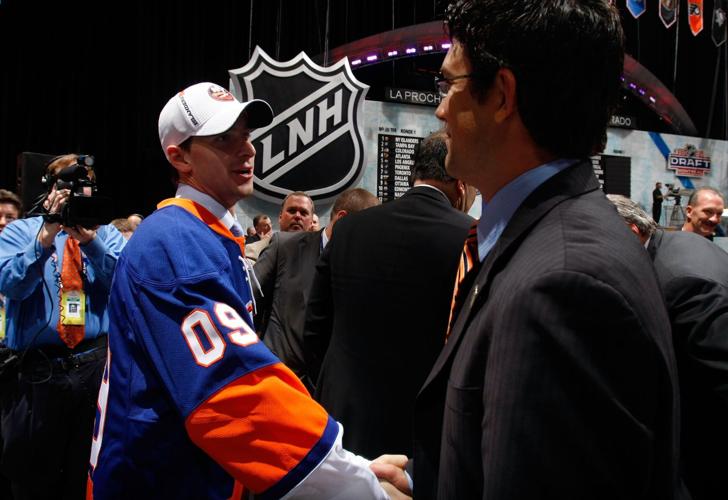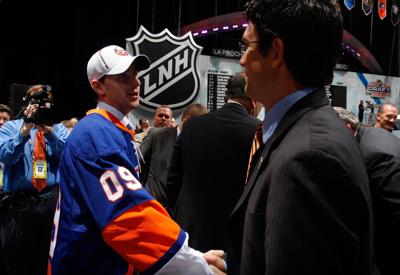John Tavares sat stone-faced beside his mother and father inside Montreal’s Bell Centre on a June night in 2009, wondering if the New York Islanders would choose him first in the NHL draft. Others thought it might be Victor Hedman. Or Matt Duchene.
All Tavares remembers is the anxiety.
ãThose final moments had a lot of buildup,ã the Maple Leafs captain said. ãIt was a lot of hard work to get to that moment and to hear your name called, it was great. Had a lot of friends and family there. It was a special moment for sure.ã
When then-Islanders GM Garth Snow called his name, Tavares finally smiled and turned to hug his mother, then his father, then both. Then he removed his suit coat and after a few more hugs of family, friends, well-wishers and other draftees, he walked down to rink level, past the rows of tables for each NHL teams who had their various war-rooms of scouts, coaches and executives on-hand. Then it was up to the podium, a handshake with NHL commissioner Gary Bettman, and finally a formal greeting with Snow, Islanders owner Charles Wang and other executives.
ãIt was awesome,ã said Tavares. ãI loved it, especially with it being Montreal, with the passion that city has for hockey.ã
It was made-for-TV theatre that created a once-in-a-lifetime memory for a young hockey player. Multiply that by the hundreds of prospects who show up every year since the draft opened up to the public in 1980 and those special memories have carried over through generations of players.
ãI got drafted by my favourite team as a kid, which was really special,ã said Duchene, who went third to Colorado. ãHearing my name, hugging my parents, putting the jersey on I think are the best parts.ã
That’s all about to change. This week’s draft in Las Vegas will be the last NHL draft of its kind. The league has decided to go to something closer to an NBA-style draft, one in which the teams stay home while the top prospects ã with possibly just a few family members ã gather to hear if they’ve been selected.
Part of the reason is cost. With the addition of analytics staff and special assistants, the front offices are huge now compared to even just 10 years ago. That adds to flight and accommodation costs.
Another part of the reason is timing. The draft used to be about 10 days from free agency on July 1, but this year basically butts up against it. The managers believe all that travelling time is better spent working on a free agency strategy.
ãI’m a little bit old-school. There’s a human element to it that I think will be missed,”ô said Dallas coach Pete DeBoer. ãIt’s the one time a year everybody can get together without the pressure and games and you can spend time together.ã
Indeed the draft has been a bit like a job fair with coaches, scouts and young managers each looking for that next opportunity, shaking the hands of people they might one day get a chance to work for.
ãWe held a coaches symposium last year in Nashville, with 700 coaches,ã said DeBoer. ãWe could share as NHL staffs with local coaches and coaches from around the country. You would lose the ability to do those type of things.ã
Then there are those draft-floor trades, which is also great theatre. Simply watching GMs move from table to table, wondering what the conversation might be about.
There were 12 trades during the draft last year and 16 in 2022.
The draft, as is, will go out in style. It’ll be held at the Sphere, Vegas’s otherworldly venue that includes a 160,000 square-foot LED screen, which wraps up, over and around the audience, creating a fully immersive visual environment. It will be the first time an event will be broadcast live from the Sphere.

Phish perform during night one of their four-night run at Sphere on April 18 in Las Vegas, Nevada.
Rich Fury/Sphere Entertainment GroupThe draft takes place over two days. The first round is in prime time involving the top prospects feted typically as can’t-miss stars. The second day features rounds two through seven, with teams motoring through those picks as quickly as possible. But in the current format, there’s still drama.
ãI remember I was in the stands and, my name gets called and my grandpa was sitting at the top, and I ran up and gave him a big hug,ã said Oilers forward Zach Hyman, drafted 123rd overall in 2010 by Florida.
ãSomeone was holding the Florida Panthers jersey at the bottom of the steps, and I ran down, got the jersey on. And I wasn’t a high prospect. So that’s the first time I was experiencing this NHL moment. And then they take you to do some media, and I’m an 18-year-old fifth-round draft pick doing media. It was an amazing experience.ã
Former Leafs coach Sheldon Keefe, a second-round pick of the Lightning in 1999, experienced it as a player and a coach.
ãWhen you’re not a guy that’s expected to go really early, you don’t know when you’re going to go and you’re on eggshells, especially as it gets in the neighbourhood of where you might get picked,ã said Keefe. ãBut it’s an exciting time. I do enjoy it. I do enjoy being there on day one. When the player enters the organization, I think there’s something to that, to being a part of it and getting to know the player and seeing him right away. They see you from day one. There’s some value in that for sure.ã
The thinking regarding the draft changed during COVID, when the league was forced to draft remotely. That was the year the Rangers chose Alexis Lafreniere first overall. He had none of the bells and whistles that accompanied previous first overall picks. He stayed home, and watched the draft on TV.
ãIt was definitely different,ã said Lafreniere. ãBut it was a super good moment. A special moment. And I got to be with my family. So it was fun.ã
Keefe said there’s a lot of downtime between picks that can quite frankly be boring.
ã(In COVID), when we were in our own facilities, it’s a lot more comfortable and you’re able to have a lot more conversations. I see benefits all the way around. It wasn’t an easy decision to make.ã
The exact form that the 2026 draft will take has not been decided. There’s still a chance the managers will backtrack from the conference call idea.
ãI’ve always liked how it’s been done, but I do understand the stresses of free agency very well as a player, so I can’t imagine what these managers go through,ã said Duchene.
ãThat’s the way our whole world’s going,ã said DeBoer. ãFile in and get in line for it because that’s the way things are going.ã





























To join the conversation set a first and last name in your user profile.
Sign in or register for free to join the Conversation